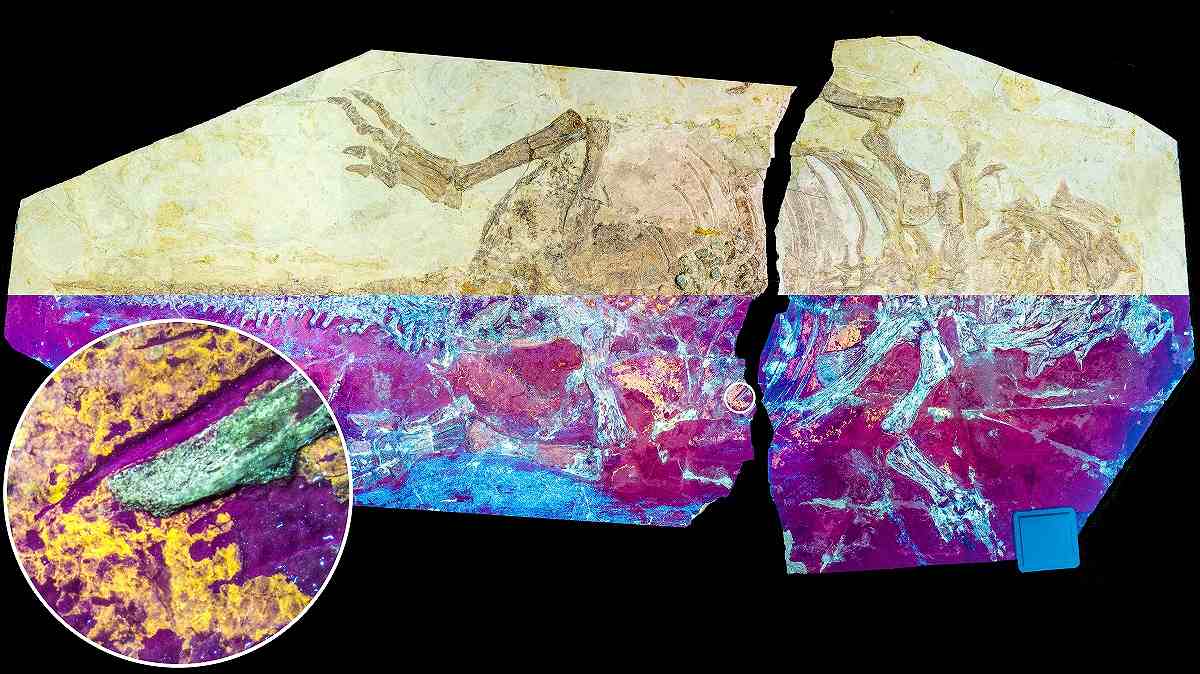
The orange-yellow fluorescence of fossilized skin of Psittacosaurus is seen in the lower half of this undated photo in UV light.
17:21 JST, May 30, 2024
A new fossil of the Cretaceous Period dinosaur Psittacosaurus, a dog-sized herbivore with a parrot-like beak, that was donated to a Chinese university came with a surprise — one revealed only after scientists viewed it under ultraviolet light.
It retained large patches of beautifully preserved skin, down to its cellular structure, providing new insight into skin evolution in feathered dinosaurs. The fossil points to “zoned development” in the skin of these dinosaurs, researchers said, with Psittacosaurus and probably other feathered dinosaurs possessing scaly, reptile-like skin on body regions without feathers, with soft, bird-like skin on areas with feathers.
“Initially we didn’t really have much hope of finding any soft tissues because, to the naked eye, our specimen appears to preserve only the bones. We didn’t give up, though, because we knew that during fossilization soft tissues can be replaced by minerals, which may blend in with the sediments,” said Zixiao Yang, a postdoctoral researcher in paleontology at University College Cork in Ireland and lead author of the study published on May 21 in the journal Nature Communications.
“When I turned on the UV light, I could feel my heart almost skip a beat. Large patches of scaly skin, covering the chest and belly, were glowing in a striking golden-yellow color under the UV. The fossil skin looked really exquisite, covered by tiny, rounded scales of about one millimeter wide,” Yang said.
Fossils of any soft tissues are rare. Skin fossils of this quality are rarer still.
Unearthed in northeastern China, the nearly complete fossil, dating to roughly 130 million years ago, is of a juvenile Psittacosaurus (pronounced SIT-ak-oh-sawr-us), about 66 centimeters long and approximately 3 years old when it died. It was donated in 2021 to Nanjing University from a private collection.
Psittacosaurus is an early member of the horned dinosaur lineage, called ceratopsians, that later produced large beasts like Triceratops. Psittacosaurus itself lacked horns. Its name means “parrot lizard” based on its protruding beak, adapted for eating plants.
Many dinosaurs had feathers. In fact, birds evolved from small feathered dinosaurs. The first rudimentary feathers are thought to have evolved from reptilian scales nearly 250 million years ago in animals ancestral to dinosaurs and the flying reptiles called pterosaurs.
Psittacosaurus had simple, bristle-like feathers atop its tail. The rest of its body was covered by scaly skin. The fossil did not have skin from the dinosaur’s feathered regions, but the researchers think these areas had bird-like skin.
“This discovery adds nuance to our understanding of feather evolution. The acquisition of modern, bird-like skin happened only locally on the body. Tough, reptile-style skin remained essential in body regions not protected by feathers,” said University College Cork paleontology professor and study coauthor Maria McNamara.
The skin of birds exhibits multiple adaptations for feathers.
Birds have a dermal network of microscopic muscles that encircles each feather and acts like a hydraulic system, including muscles that pull feathers in different directions. There also is a network of smooth muscles under the skin that keeps feathers separated, as well as deposits of fatty tissue anchored to the base of the skin that create an even skin surface and feather orientation. In addition, feathers are connected by a system of sensory nerve fibers.
“Until now, we haven’t known whether the skin of dinosaurs and their relatives evolved these skin adaptations first and feathers later, or whether they evolved at the same time, and in which parts of the body,” McNamara said.
The Psittacosaurus fossil “strongly suggests that evolution of feathers — and the new skin adaptations — happened at the same time,” McNamara said.
The dinosaur’s scaly skin closely resembled the skin of today’s reptiles.
“They are similar in many aspects, including the shape, size, arrangement and composition of skin cells and the way the skin produces color patterns,” Yang said.
Related Tags
"Science & Nature" POPULAR ARTICLE
-

Genome Study Reveals Milestone in History of Cat Domestication
-

Big Leap in Quest to Get to Bottom of Climate Ice Mystery
-

Security Camera Footage Vulnerable to Outside Access; Investigation Finds 3,000 Pieces Exposed Online
-

Paws on Parade: Nairobi’s Dogs Dazzle at ‘Pawchella’
-

Japan Set to Participate in EU’s R&D Framework, Aims to Boost Cooperation in Tech, Energy
JN ACCESS RANKING
-

Keidanren Chairman Yoshinobu Tsutsui Visits Kashiwazaki-Kariwa Nuclear Power Plant; Inspects New Emergency Safety System
-

Imports of Rare Earths from China Facing Delays, May Be Caused by Deterioration of Japan-China Relations
-

University of Tokyo Professor Discusses Japanese Economic Security in Interview Ahead of Forum
-

Tokyo Economic Security Forum to Hold Inaugural Meeting Amid Tense Global Environment
-

Japan Pulls out of Vietnam Nuclear Project, Complicating Hanoi’s Power Plans
























